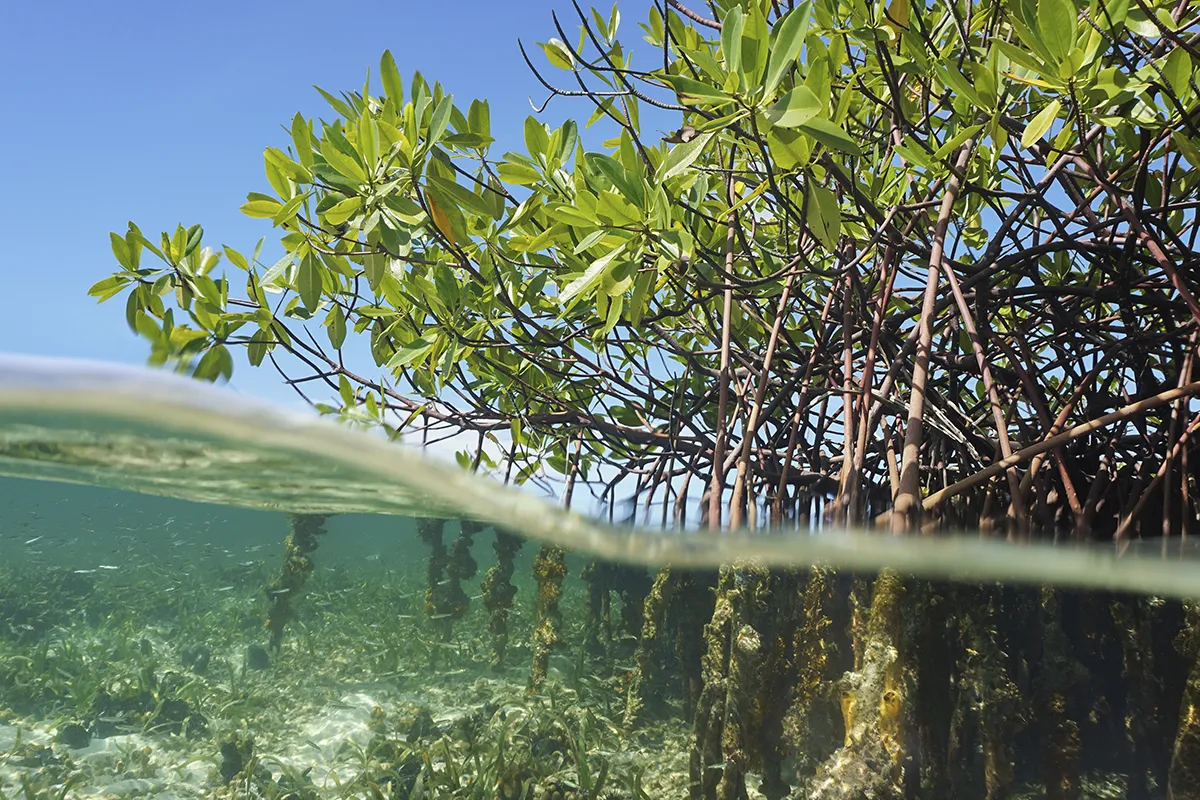The Right to Steward: Protecting People and Planet in Asia’s Mangrove Forests

Chumpou Khmao Village sits along a single dirt road in Cambodia’s Preah Sihanouk Province, nestled next to the sea. Hout Sen, a longtime resident of Chumpou Khmao, spends her days along the seashore harvesting clams, collecting crabs, and catching shrimp and fish. By fishing with her family, she earns enough income to pay for her children’s education in addition to food and other expenses.
Most families in Chumpou Khmao earn their livelihood this way. All generations participate in this way of life: children collect clams and crabs along the shore, and teenagers and adults travel out to sea to fish.
Marine life is abundant due to the 512 hectares of mangrove forest that sit between the village and the sea — but increasingly, pollution, overcutting, and illegal fishing jeopardize the future of these vital forests.
Mangrove forests: An indispensable ecosystem
The mangroves of Chumpou Khmao are part of one of the world’s largest swaths of mangrove forests — 4.6 million hectares stretching across the Bay of Bengal and Southeast Asia. A blue carbon sink, mangrove forests possess the powerful ability to sequester four times more carbon than tropical rainforests. They are also a biodiversity hotspot, offering vital habitat to hundreds of threatened species.
The brackish water enveloping mangroves is a nursery for fisheries, enabling young fish and invertebrates to grow while protected from larger predators and ocean currents. But mangroves shield humans as well. Their distinctive tangled roots act as a buffer between communities and coastal storm surges. Protecting mangrove trees is one thousand times cheaper per kilometer than building seawalls.
From fisheries, storm buffering, and other ecosystem services, one hectare of mangrove forests offers between USD $33,000 and $57,000 in annual economic benefits. Yet increasingly, expansion of plantations and urban centers is destroying mangroves and displacing longtime residents. Shrimp farms dredge mangrove habitats and push out fishing families who have long relied on these forests for their food and livelihoods.
Environments under threat
With external pressures rising, how do we protect this indispensable ecosystem? The answer lies with the communities whose livelihoods are intertwined with the mangrove forests.
Chumpou Khmao’s residents recognize the importance of their mangrove forest and in 2008 established a community fishery — a formal marine management designation that enables the community to protect, restore, and manage their forest with formal usage and ownership rights. Yet many similar communities lack strong legal rights to the mangrove areas they depend on for food and income.
Families have little incentive to invest in the future of their coastal forests — for example, by sustainably harvesting and replanting mangroves — when they lack confidence they will have access to those resources in years to come. Insecure land rights also make it easy for large developers and shrimp enterprises to displace the people who have lived there for generations.
Conversely, with secure land rights in hand, communities hold a tool to safeguard their mangrove forests from external threats, along with the incentive to steward the forests sustainably. And with the support of organizations like Landesa, this is an achievable goal.
An ecoregion approach
In six countries forming the contiguous stretch of bioregion across the Bay of Bengal and Southeast Asia, Landesa is engaged in an ambitious law and policy initiative, the Coastal Livelihoods and Mangroves Project, to strengthen the coastal land rights of communities and protect their mangrove forests. Alongside local partners, Landesa promotes policies regarding forest tenure, land use planning, and climate mitigation and adaptation in Bangladesh, Cambodia, India, Indonesia, Myanmar, and Thailand, in addition to offering recommendations to the regional policy body ASEAN.
In Thailand, Landesa’s partnership with East-West Management Institute’s Open Development Initiative employs the data gathered using expert mapping technologies to advocate for improved national policies to protect the country’s 200,000 hectares of mangrove forest. In Cambodia, Landesa supports the national government in developing stronger policies and programs for community management of coastal areas, and works with provincial governments to issue orders to better protect mangrove areas.
Landesa also trains community fisheries like Chumpou Khmao in how to use spatial monitoring and reporting tools to map and report threats to their mangrove forests, producing data that the Government of Cambodia then analyzes to inform national policy.
Ultimately, the Coastal Livelihoods and Mangroves Project seeks to protect up to 4.6 million hectares of mangrove forests — in turn strengthening coastal land rights for almost 73 million people and mitigating nearly one billion metric tons of carbon.
Strengthen rights for people and planet
Protecting nature will not be successful unless we protect the people who depend on it.
The lives of Chumpou Khmao’s residents are woven into the roots of their mangrove forests. With the support necessary to gain secure rights, they can steward their forests to flourish for generations. As Hout Sen explains: "If we can protect our resources, we can keep eating and making a living like this forever."
About the
Series:
Who Will Speak For The Trees?
At a time when human economic development is prioritized over the needs of nature, the Who Will Speak for the Trees? series features top reforestation leaders with a broad range of restoration expertise, including climate tech, monitoring, science, finance, media, and more. These diverse voices offer expert viewpoints to instill confidence in how humanity can support nature to deliver a forested future for all living things on Earth. Join us for this ongoing series to learn more about the science of reforestation and how restoring ecosystems is part of a comprehensive climate solution.
















